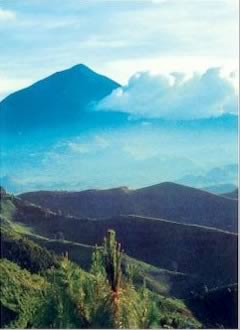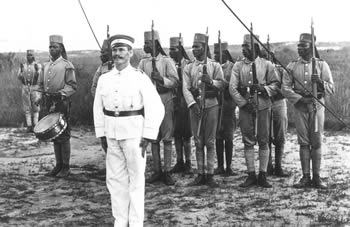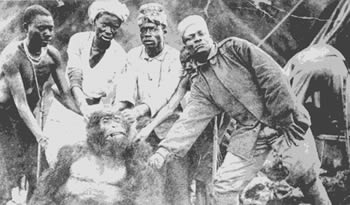
|
Discovered on October 17, 1902 on the ridges of the volcanic Virunga On the Trail of the Man who Discovered the Mountain Gorilla Captain von Beringe, together with a physician, Dr. Engeland, Corporal Ehrhardt, twenty Askaris, a machine gun and necessary porters set off from Usumbura on 19 August 1902 to visit the Sultan Msinga of Rwanda and then proceed north to reach a "row of volcanoes". The purpose of the trip was to visit the German outposts in what was then German East Africa in order to keep in touch with local chiefs and to confirm good relations, while strengthening the influence and power of the German Government in these regions. On arriving at the volcanoes, an attempt was made to climb Mount Sabyinyo. The following is a translation of Captain von Beringe's report of the expedition: "From October 16th. to 18th., senior physician Dr. Engeland and I together with only a few Askaris and the absolutely necessary baggage attempted to climb the so far unknown Kirunga ya Sabyinyo which, according to my estimation must have a height of 3300 metres. At the end of the first day we camped on a plateau at a height of 2500 metres; the natives climbed up to our campsite to generously supply us with food. We left our camp on October 17th. taking with us a tent, 8 loads of water, 5 Askaris and porters as necessary."
"After four and a half hours of tracking we reached a height of 3100 metres and tracked through bamboo forest; although using elephant trails for most of the way, we encountered much undergrowth which had to be cut before we could pass....After two hours we reached a stony area with vegetation consisting mainly of blackberry and blueberry bushes. Step by step we noticed the vegetation becoming poorer and poorer, the ascent became steeper and steeper, and climbing became more difficult - for the last one and a quarter hours we climbed only over rock. After covering the ground with moss we collected, we erected our tent on a ridge at a height of 3100 metres. The ridge was extremely narrow so that the pegs of the tent had to be secured in the abyss. The Askaris and the porters found shelter in rock caverns, which provided protection against the biting cold wind."
On the journey back, the skin and one of the hands of the animal that von Beringe collected were taken by a hyena but the rest finally arrived safely at the museum in Berlin. It was later described by a Dr. Matschi as a new subspecies of gorilla and named after von Beringe. |

 mountains by German explorer Captain Robert von Beringe, the mountain gorilla was named Gorilla gorilla beringei in honor of the Captain.
mountains by German explorer Captain Robert von Beringe, the mountain gorilla was named Gorilla gorilla beringei in honor of the Captain.

